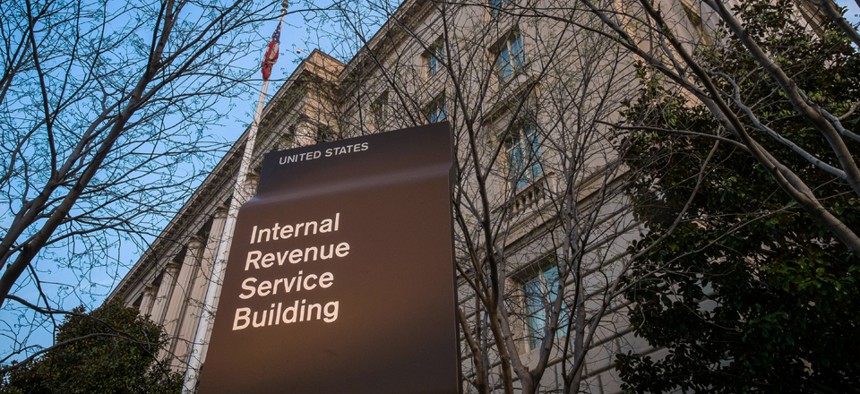
J. David Ake/AP
Commentary: 12 Ways to Clean Up the Mess at IRS
A comprehensive overhaul is needed to combat the dysfunction.
The Internal Revenue Service’s Exempt Organizations Division has received little favorable news coverage lately.
If we skip the silly claims that President Obama directed the IRS to target Tea Party groups—ostensibly to deny them recognition of tax-exempt status as social welfare organizations (a recognition they don’t really need)—there still are problems with how this controversial division operates.
Over the past 10 or 15 years, it has become increasingly dysfunctional.
In the past 12 months, a number of its managers have been sent packing. The new team is talking tough, but the way I see it, having observed the division for over 40 years, is that the laundry list of problems it now confronts won’t be solved easily.
The tax law the EO Division administers is ambiguous and complex. Many of its determinations are based on “facts and circumstances,” which, as one judge said, is no standard at all. To administer such a hodgepodge, you need smart, well-trained employees. Recently, many experienced employees have been leaving, either retiring or seeking greener pastures. New employees need training, but there is too little money in recent IRS budgets.
Even with training, the division’s current staff of about 800 nationwide is inadequate to regulate more than a million tax-exempt entities. These are groups that count for upwards of 10 percent of GDP but are matched against less than 1 percent of the IRS’ budget or employees. Since the targeting “scandal” broke in May 2013, the division’s operations have been largely at a standstill, and morale is low.
There is also the bureaucratic maze. EO Division managers must interact with other offices, each defending turf. Within the IRS that includes the Office of Chief Counsel (Washington and field units), Office of Appeals, Office of the Commissioner of Tax-Exempt/Government Entities (TE/GE), and Office of the IRS Commissioner. Treasury’s Office of Tax Policy must approve final regulations and revenue rulings. Within the EO Division are competing offices in Washington, Cincinnati and Dallas.
What’s a manager to do?
Congress (primarily House Republicans) has spent the last year trying to pin the EO problems on individuals, rather than looking at the many problems that go beyond inappropriate handling of Tea Party applications—which, while a serious problem, is a tiny piece of the EO division’s dysfunctionality.
The most welcome solution would be removing regulation of exempt organizations from the IRS’ charge. But this is beyond the agency’s power to initiate.
A practical solution in my view would involve a multifaceted, sustained effort at IRS to efficiently regulate the nonprofit sector in a fair, transparent manner. Specifically, I suggest:
- Designate one individual, reportable only to the IRS commissioner, for overall responsibility of the EO functions. Unfortunately, however, it is unlikely the Office of Chief Counsel and Treasury’s Office of Tax Policy will accept such diminution of their authority.
- Establish separate offices for EO media relations and EO congressional relations, and have these offices reach out to the press and Congress to restore public trust.
- Push transparency, including full compliance with the Freedom of Information Act and sections 6104 and 6110 of the Internal Revenue Code, which permit disclosure of exempt organization information, and establish a separate EO office to be responsible.
- Determine whether EO has sufficient employees to run an effective review of new applications for tax-exempt status. Currently, the IRS receives about 80,000 applications a year; if the IRS cannot manage this workload, it should seriously consider allowing organizations to self-certify, backed by examinations.
- Remove the Appeals Division from review of denied applications by keeping protest rights within the EO Division, which would enhance consistency and fairness.
- Reorient the examination function to focus on egregious cases that are IRS-identified or named in public complaints or in the press.
- Commit to a six-month turnaround for private letter rulings to taxpayers, with extensions beyond one year requiring approval by the TE/GE commissioner.
- Address the problems with regulating churches or declare that the IRS is unable to do so under current restraints and public disapproval.
- Re-establish the branch that used to handle all matters not taken care of elsewhere, which will help prevent problems from languishing.
- Identify the responsibilities of the Ogden (Utah) Service Center for both the benefit of IRS employees working EO cases and tax practitioners, and provide a contact.
- Fund and reintroduce the annual EO continuing professional education textbooks for both the public and IRS internal training.
- Require all new EO managers to take a course in basic EO tax law or pass an exam. Amazingly, the IRS has often assumed its managers do not have to know the tax law for which they are responsible.
The IRS’ EO functions must have adequate funding and a trained, motivated workforce with competent, demanding managers. Currently, it is a ship taking on water, in danger of sinking, to the detriment of the public interest and tax-exempt organizations.
Paul Streckfus is editor and publisher of the daily EO Tax Journal. He spent six years as a tax law specialist at the IRS’ Exempt Organizations Division and has worked as a tax attorney and as a staffer at Tax Analysts in Falls Church, Va.






